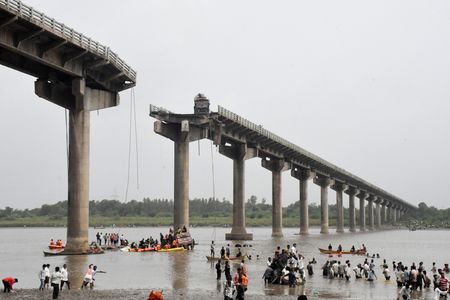By Joe Cash
BEIJING (Reuters) -Torrential rains swept across swathes of China on Wednesday as Tropical Storm Danas drenched coastal tech hubs while monsoonal rains further inland unleashed deadly landslides and flash floods over a 1,400-km (870-mile) arc.
Compounding the challenge for authorities, a subtropical high-pressure system has been baking the $19 trillion economy’s more north-easterly seaboard and central provinces since last week, straining power grids and parching croplands.
The world’s No.2 economy faces growing threats from extreme weather, which meteorologists link to climate change. Each year, the impact threatens to wipe out tens of billions of dollars worth of commercial activity, alongside loss of life, as ageing flood defences are overwhelmed and infrastructure gaps – such as limited access to air conditioning – are exposed.
Chinese weather authorities urged residents to stay indoors as Storm Danas – which has weakened from a typhoon after claiming two lives in Taiwan – began dumping the water it had sucked up over the South China Sea and Taiwan Strait on the coastal provinces of Zhejiang and Fujian.
Danas is forecast to deposit up to 300 millimetres (30 centimetres) of rain in some parts, shutting schools and putting officials along rivers feeding key ports in the cities of Fuzhou and Xiamen on alert for flash floods, according to China’s state broadcaster.
ON FLOOD ALERT
Although no longer a typhoon, Danas’ residual vortex and the substantial amount of water it carries could still wreak havoc in southern China, where rapid urbanisation has sealed vast stretches of land beneath impermeable concrete.
That risk materialised some 1,500 km (932 miles) away in Yibin, a city in southwestern Sichuan province, where over 6,000 people were evacuated on Wednesday after 14 hours of rain. State broadcaster CCTV showed firefighters carrying residents out of rising waters in the lower floors of apartment buildings.
In Zhaotong, a city about a three-hour drive from Yibin, more than 7,000 people were evacuated and five were reported missing amid heavy rains, CCTV reported on Wednesday. One county recorded 227.8 mm of rainfall within 24 hours, the highest local single-day total since records began in 1958.
Meanwhile, over 300 people had to be relocated following a flash flood near the foothills of the Himalayas in China’s Tibet, caused by a river in Gyirong bursting its banks.
Conditions in northern China were not much better, as authorities in the city of Shijiazhuang in Hebei province activated emergency flood protocols after some districts received more than 100 millimetres of overnight rain.
HEATWAVES
The subtropical high-pressure system, straddling the monsoonal clouds in China’s interior and the rain bands of Danas, continued to hang over central China and the eastern seaboard running from Shanghai towards Beijing on Wednesday, bringing near-record heat to the mega-cities of Shanghai, Wuhan and Changsha.
People in China’s northeast were encouraged to avoid going outside during the hottest hours of the day and to keep hydrated, following reports of heatstroke-related fatalities over the past week.
China does not provide an official count of heat-related deaths, although domestic media occasionally report fatalities citing local authorities.
In 2022, the country endured a 79-day heatwave from mid-June to late August — its worst since 1961. A 2023 study published in the medical journal The Lancet estimated that more than 50,000 heat-related deaths occurred that year.
(Reporting by Joe Cash and Ethan Wang; Editing by Saad Sayeed and Bernadette Baum)







